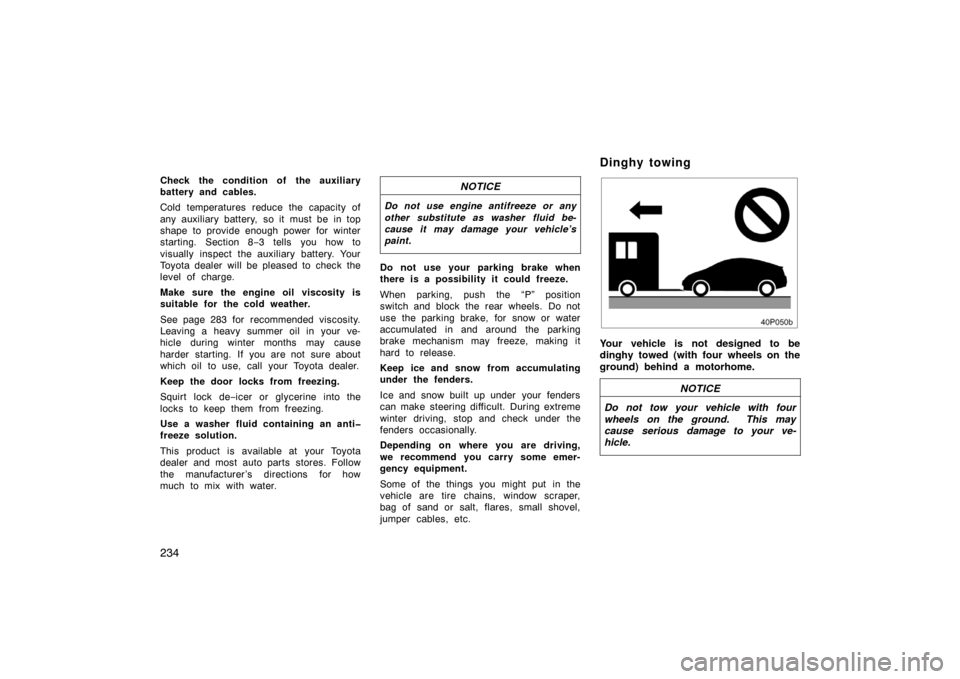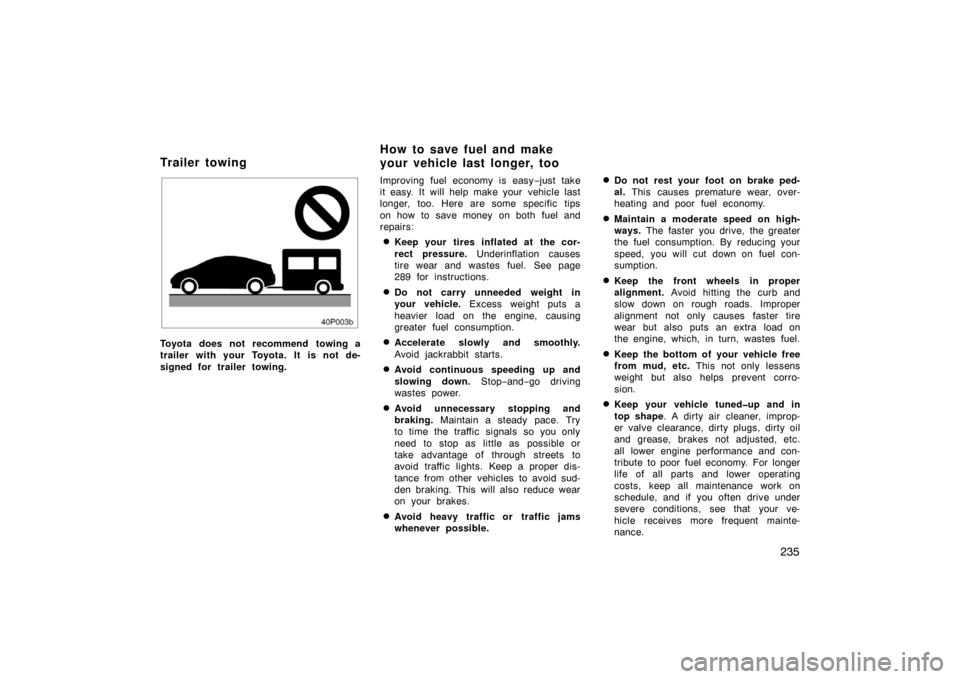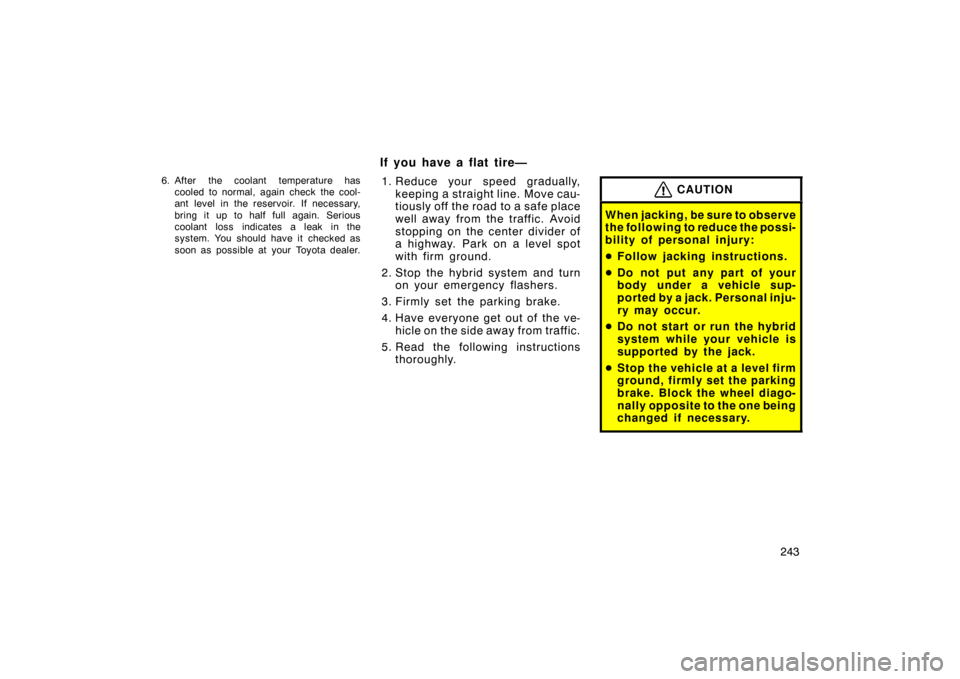Page 234 of 333

234
Check the condition of the auxiliary
battery and cables.
Cold temperatures reduce the capacity of
any auxiliary battery, so it must be in top
shape to provide enough power for winter
starting. Section 8−3 tells you how to
visually inspect the auxiliary battery. Your
Toyota dealer will be pleased to check the
level of charge.
Make sure the engine oil viscosity is
suitable for the cold weather.
See page 283 for recommended viscosity.
Leaving a heavy summer oil in your ve-
hicle during winter months may cause
harder starting. If you are not sure about
which oil to use, call your Toyota dealer.
Keep the door locks from freezing.
Squirt lock de −icer or glycerine into the
locks to keep them from freezing.
Use a washer fluid containing an anti�
freeze solution.
This product is available at your Toyota
dealer and most auto parts stores. Follow
the manufacturer ’s directions for how
much to mix with water.NOTICE
Do not use engine antifreeze or any
other substitute as washer fluid be-
cause it may damage your vehicle’s
paint.
Do not use your parking brake when
there is a possibility it could freeze.
When parking, push the “P” position
switch and block the rear wheels. Do not
use the parking brake, for snow or water
accumulated in and around the parking
brake mechanism may freeze, making it
hard to release.
Keep ice and snow from accumulating
under the fenders.
Ice and snow built up under your fenders
can make steering difficult. During extreme
winter driving, stop and check under the
fenders occasionally.
Depending on where you are driving,
we recommend you carry some emer-
gency equipment.
Some of the things you might put in the
vehicle are tire chains, window scraper,
bag of sand or salt, flares, small shovel,
jumper cables, etc.
40p050b
Your vehicle is not designed to be
dinghy towed (with four wheels on the
ground) behind a motorhome.
NOTICE
Do not tow your vehicle with four
wheels on the ground. This may
cause serious damage to your ve-
hicle.
Dinghy towing
Page 235 of 333

235
40p003b
Toyota does not recommend towing a
trailer with your Toyota. It is not de-
signed for trailer towing.Improving fuel economy is easy
−just take
it easy. It will help make your vehicle last
longer, too. Here are some specific tips
on how to save money on both fuel and
repairs:
�Keep your tires inflated at the cor-
rect pressure. Underinflation causes
tire wear and wastes fuel. See page
289 for instructions.
�Do not carry unneeded weight in
your vehicle. Excess weight puts a
heavier load on the engine, causing
greater fuel consumption.
�Accelerate slowly and smoothly.
Avoid jackrabbit starts.
�Avoid continuous speeding up and
slowing down. Stop−and− go driving
wastes power.
�Avoid unnecessary stopping and
braking. Maintain a steady pace. Try
to time the traffic signals so you only
need to stop as little as possible or
take advantage of through streets to
avoid traffic lights. Keep a proper dis-
tance from other vehicles to avoid sud-
den braking. This will also reduce wear
on your brakes.
�Avoid heavy traffic or traffic jams
whenever possible.
�Do not rest your foot on brake ped-
al. This causes premature wear, over-
heating and poor fuel economy.
�Maintain a moderate speed on high-
ways. The faster you drive, the greater
the fuel consumption. By reducing your
speed, you will cut down on fuel con-
sumption.
�Keep the front wheels in proper
alignment. Avoid hitting the curb and
slow down on rough roads. Improper
alignment not only causes faster tire
wear but also puts an extra load on
the engine, which, in turn, wastes fuel.
�Keep the bottom of your vehicle free
from mud, etc. This not only lessens
weight but also helps prevent corro-
sion.
�Keep your vehicle tuned�up and in
top shape . A dirty air cleaner, improp-
er valve clearance, dirty plugs, dirty oil
and grease, brakes not adjusted, etc.
all lower engine performance and con-
tribute to poor fuel economy. For longer
life of all parts and lower operating
costs, keep all maintenance work on
schedule, and if you often drive under
severe conditions, see that your ve-
hicle receives more frequent mainte-
nance.
Trailer towing How to save fuel and make
your vehicle last longer, too
Page 238 of 333

238
Before making these checks, make sure
you have followed the correct starting
procedure given in “How to start the
hybrid system” on page 230 and that you
have sufficient fuel. Also check whether
the other keys will start the hybrid
system. If they work, your key may be
broken. Have the key checked at your
Toyota dealer. If none of your keys work,
there may be a malfunction in the hybrid
vehicle immobilizer system. Call your
Toyota dealer. (See “Keys” on page 18.)
If the instrument cluster dims or the
instrument cluster display turns off
with the hybrid system on—1. Check that the auxiliary battery termi- nals are tight and clean.
2. If the auxiliary battery terminals are O.K., the auxiliary battery is dis-
charged. You may try jump starting.
See “(b) Jump starting” for further in-
structions.
NOTICE
Hybrid vehicles cannot be push�
started.
If the instrument cluster is shown in
appropriate brightness with the hybrid
system is in the “IG�ON” mode—
The hybrid vehicle system is suspected to
be faulty. Contact your Toyota dealer. If the auxiliary battery is discharged,
the hybrid system can be started by
jump starting. Depending on the vehicle
condition, the engine may not start.
To avoid serious personal injury and
damage to your vehicle which might re-
sult from battery explosion, acid burns,
electrical burns, or damaged electronic
components, these instructions must be
followed precisely.
If the auxiliary battery is discharged, you
cannot access to the auxiliary battery in
the luggage compartment because the
back door cannot be opened. Use the ex-
clusive jump starting terminal in the en-
gine compartment. For details, see “JUMP
STARTING PROCEDURE” on page 239.
NOTICE
If the auxiliary battery is discharged
with the transaxle in “P”, your vehicle
cannot be moved unless the front
wheels are raised. This is because the
front wheels are locked by means of
the parking lock mechanism.
If you are unsure about how to follow this
procedure, we strongly recommend that
you seek the help of a competent qualified
technician or towing service.
If your vehicle will not start—
(a) Simple checks
(b) Jump starting
Page 243 of 333

243
6. After the coolant temperature hascooled to normal, again check the cool-
ant level in the reservoir. If necessary,
bring it up to half full again. Serious
coolant loss indicates a leak in the
system. You s hould have it checked as
soon as possible at your Toyota dealer.1. Reduce your speed gradually, keeping a straight line. Move cau-
tiously off the road to a safe place
well away from the traffic. Avoid
stopping on the center divider of
a highway. Park on a level spot
with firm ground.
2. Stop the hybrid system and turn on your emergency flashers.
3. Firmly set the parking brake.
4. Have everyone get out of the ve- hicle on the side away from traffic.
5. Read the following instructions thoroughly.CAUTION
When jacking, be sure to observe
the following to reduce the possi-
bility of personal injury:
�Follow jacking instructions.
� Do not put any part of your
body under a vehicle sup-
ported by a jack. Personal inju-
ry may occu r.
� Do not start or run the hybrid
system while your vehicle is
supported by the j ack.
� Stop the vehicle at a level firm
ground, firmly set the parking
brake. Block the wheel diago-
nally opposite to the one being
changed if necessary.
If you have a flat tire—
Page 244 of 333
244
�Make sure to set the jack prop-
erly in the jack point. Raising
the vehicle with jack improper-
ly positioned will damage the
vehicle or may allow the ve-
hicle to fall off the jack and
cause personal injury.
� Never get under the vehicle
when the vehicle is supported
by the jack alone.
� Use the jack only for lifting
your vehicle during wheel
changing.
� Do not raise the vehicle with
someone in the vehicle.
� When raising the vehicle, do
not place any objects on top
of or underneath the jack.
� Raise the vehicle only high
enough to remove and change
the tire.NOTICE
Do not continue driving with a
deflated tire. Driving even a
short distance can damage a
tire and wheel beyond repair.
50p007a
Compact spare tire
The compact spare tire is designed
for temporary emergency use only.
The compact spare tire is identified
by the distinctive wording “TEM-
PORARY USE ONLY” molded into the
side wall of the tire.
Page 246 of 333
246
50p008c
1. Get the required tools and sparetire.
1 Wheel nut wrench
2 Jack handle
3Jack
4 Spare tire
To open the luggage storage box, see
“Luggage storage box” on page 197.
To prepare yourself for an emergency,
you should familiarize yourself with
the use of the jack, each of the tools
and their storage locations.
50p009a
To remove the jack, unlock the tight-
ening strap.
To store the jack, make sure it is se-
curely held by the tightening strap.
50p010e
To remove the spare tire:
1. Remove the luggage storage box.
2. Loosen the bolt and remove it.
3. Remove the jack box.
Then take the spare tire out of the
vehicle.
When storing the spare tire, put it in
place with the inner side of the wheel
facing up. Then secure the tire by re-
peating the above removal steps in
reverse order to prevent it from flying
forward during a collision or sudden
braking.
—Required tools and spare
tire
Page 247 of 333
247
When installing the jack box, align the
arrows on the jack
box with the ones
on the body.
50p011b
2. Block the wheel diagonally op-
posite the flat tire to keep the
vehicle from rolling when it is
jacked up.
When chocking the wheel, place a
wheel block in front of one of the front
wheels or behind one of the rear
wheels.
50p013d
3. Loosen all the wheel nuts.
Always loosen the wheel nuts before
raising the vehicle.
Turn the wheel nuts counterclockwise
to loosen them. To get maximum le-
verage, fit the wrench to the nut so
that the handle is on the right side,
as shown above. Grab the wrench
near the end of the handle and pull
up on the handle. Be careful that the
wrench does not slip off the nut.
Do not remove the nuts yet—just un-
screw them about one −half turn.
—Blocking the wheel —Loosening wheel nuts
Page 248 of 333
248
CAUTION
Never use oil or grease on the
bolts or nuts. The nuts may loos-
en and the wheels may fall off,
which could cause a serious ac-
cident.
50p014e
4. Position the jack at the jackpoints as shown.
Make sure the jack is positioned on
a level and solid place.
50p015c
5. After making sure no one is in the vehicle, raise it high enough
so that the spare tire can be
installed.
Remember you will need more ground
clearance when putting on the spare
tire than when removing the flat tire.
To raise the vehicl e, insert the jack
handle into the jack (it is a loose fit)
and turn it clockwise. As the jack
touches the vehicle and begins to lift,
double −check that it is properly posi-
tioned.
—Positioning the jack —Raising your vehicle